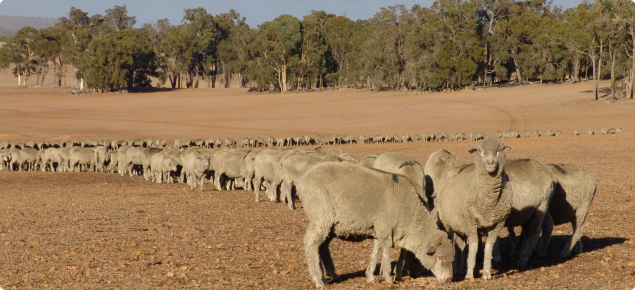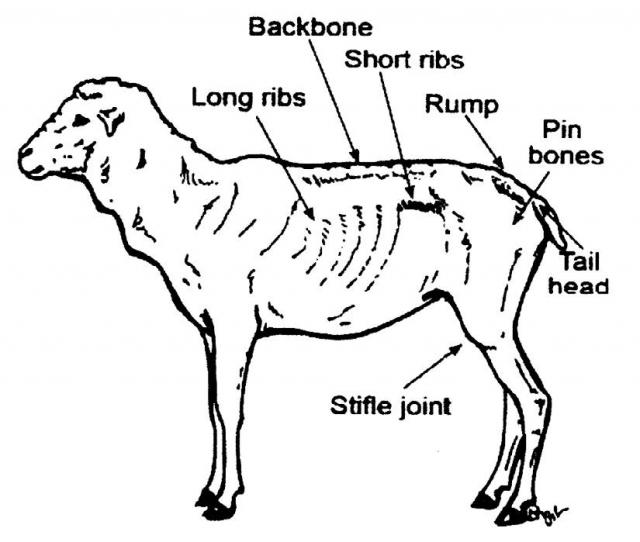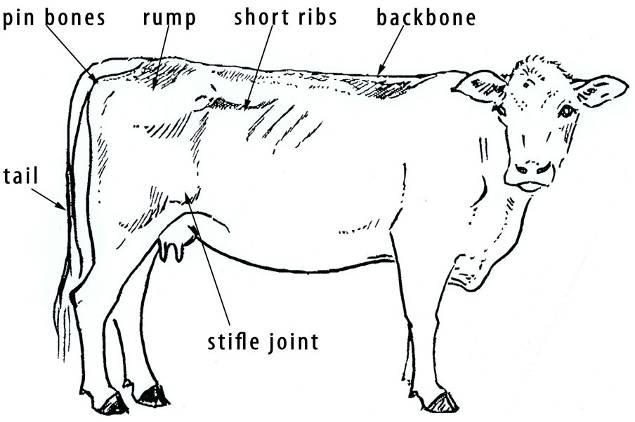Welfare decisions for sheep
As animals fall to body condition score (BCS) 1.5 or less, their strength and ability to withstand the rigors of transport are greatly reduced. If they lose condition further they are at risk of dying. It is not acceptable to allow livestock to reach this condition or to transport weakened animals. An easy method to condition score sheep is described on the Condition scoring of sheep page. The Sheep Condition Scoring app is another handy tool.
Decisions about feeding and whether animals are fit for transport need to be made by livestock managers, advisers and transport operators. Decisions also need to be made regarding humane destruction on the property if warranted.
These are difficult decisions and place the people making them under a great deal of emotional stress.
Assessing animals
The below figure shows the key sites for assessing an animal’s status. Use Table 1 to decide on the status of animals and the action required.
| Indicators | At risk BCS 1.5 | Substantial risk BCS 1 | Extreme risk <BCS 1 |
|---|---|---|---|
| General description | Lean, muscle wastage evident. Reduced reproductive performance likely. | Significant muscle wastage. Unlikely to conceive. Able to recover in time if adequately fed. | Weak, with very low body reserves. At risk of death from cold, wet weather or other stress. Recovery dependent on high quality care and will be slow. |
| Backbone | Visible. | Spines of backbone identifiable. | Spines of backbone easily identifiable. |
| Short ribs | Slightly visible individually, more so in Merino sheep. | Prominent and very sharp to touch. | Very prominent and easy to see individually. |
| Inside pin bones | Slightly sunken. | Sunken. | Deeply sunken to the bone. |
| Muscle wastage | Rump muscle concave. | Rump muscle concave. Muscle wastage in loin and leg muscle evident. | Obvious over whole body. Rump and leg muscles deeply concave. |
| Stifle joint | Stifle joint not identifiable. | Stifle joint not identifiable. | Stifle joint identifiable. |
| Tail bones | Individual bones not identifiable. | Individual bones just able to be felt. | Individual bones easily felt. |
| Appearance and behaviour | Animal looks ‘narrow’ when viewed from behind Appears alert and mobile, will attempt to eat grass, head to the ground. | Able to stand but listless, dull. Sunken or humped back, head lowered. | Lacking energy, dull and listless, may be recumbent and unlikely to stand. |
| Mobility | Normal gait. | Mobile, able to lie down and rise but may have some difficulty. | Unsteady gait, may drag feet or 'teeter'. Difficult to lie down and rise. |
| Lambing requirements & risks associated with lambing** | Some assistance required, high possibility of losing lamb during birth or on first day after birth. High possibility of pregnancy toxaemia and/or hypocalcaemia. Separate pregnant animals within this condition score range and care for and feed a high energy supplement separately. Necessary to seek advice on adequate feeding from a professional (for example veterinarian, development officer). | Will need a lot of assistance - ewe and lamb may not survive. | Extremely unlikely that lamb and ewe will survive lambing. |
| Transport, sale** | Unfit for transport except in accordance with veterinary advice. Unfit for sale at saleyards. | Unfit for transport except in accordance with veterinary advice. Unfit for sale at saleyards. | Unfit for transport except in accordance with veterinary advice. Unfit for sale at saleyards. |
| Action required | Feed adequately to prevent extra weight loss. Supervise and be ready to assist during lambing — supervise lamb after birth. | Must be fed adequately immediately to prevent weight loss. | Very high level of care and nutrition required or humanely destroy on farm. |
Criteria for destruction on property
Some sheep may require humane destruction on property. They should be destroyed if they are in poor or very poor condition as described on the next page and meet any of the following conditions:
- they fall down or are knocked over easily
- they are unable to stand without assistance
- they have an unsteady gait
- adequate good quality feed cannot be provided
- adequate good quality water cannot be provided
- it is uneconomic
- not possible to transport, sell or feed due to circumstances.
Condition score 1 sheep may also need to be destroyed when treatment, transport or feeding is not possible. Sheep must not be allowed to starve to death.
This information has been derived from Blackwood, I, Garden, B, Littler, B, Paul, A and Prowse, K, 2007, Primefact 619, Welfare decisions for beef cows, Industry and Investment NSW, and Thompson, A, Kelly, J, and Paul, A, 2013, Welfare Scoring nutritionally deprived beef cattle, dairy cattle and their crosses, sheep and horses, NSW Department of Primary Industries.
Welfare decisions for cattle
At times such as during drought, reduced feed intake causes beef cows to lose body condition. As this happens, their milk dries up and their commercial beef value declines.
If they lose condition further, their body reserves can become insufficient for them to withstand mustering, yarding, transport or sale. If they become very weak, they are at risk of death during wet weather or if placed under any form of stress. It is not acceptable to allow stock to reach this condition or to transport such weakened animals.
Livestock managers, advisers, transport operators and welfare officials need to make decisions about feeding, suitability for transport or sale of cattle, and in extreme cases, their humane destruction on the property. These decisions are difficult and are often made by people under heavy emotional stress.
Assessing animals
The diagram below shows the key sites for assessing an animal’s condition. Use the table below it to decide which category the animal fits into and what action to take.
| Cow Body Condition Score (BCS) | At risk BCS 1.5 | Substantial risk BCS 1 | Extreme risk BCS 0 |
|---|---|---|---|
| — | 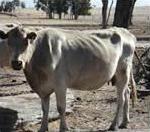 | 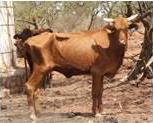 | 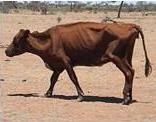 |
| Brief description | Lean but strong and healthy with some significant muscle wastage. Reduced reproductive performance likely. | At risk with significant muscle wastage an no fat reserves. Able to recover to condition score 2 if adequately fed within two months. Unlikely to conceive. | Weak, with very low body reserves. At risk of death from cold, wet weather or other stress. Recovery dependent on high quality feed and care. Recovery to condition score 2 will take more than two months. |
| Transport, sale | Suitable for transport and sale but with minimum time off feed. | Unsuitable for sale through saleyards or transport over long distances. | Not fit to travel. |
| Behaviour and mobility | Bright, alert and normal mobile gait. | Alert, but less energetic. Gait is normal but grooming behaviour is affected. Mobile, able to lie down/rise. | Dull appearance/no grooming behaviour and reduced cud chewing. Slow unsteady gait, and may drag hind feet or plait hind legs. Difficulty lying down/standing up. Has difficulty maitaining balance. |
| Backbone | Easily seen. | Spines of backbone individually identifiable. | Spines of backbone individually identifiable. |
| Short ribs | Visible. Sharp to touch. | Prominent and very sharp to touch. | Very prominent and easy to see individually. |
| Inside pin bones | Slightly sunken. | Sunken. | Deeply sunken to the bone. |
| Muscle wastage | Rump muscle concave (between hooks and pins). | Rump muscle concave. Muscle wastage in loin and leg muscle evident. | Muscle wastage obvious over whole leg body. Rump and leg muscles deeply concave. |
| Stifle joint | — | Stifle joint not identifiable. | Stifle joint identifiable. |
| Tail bones | Individual bones not identifiable. | Individual bones just able to be felt. | Individual bones easily felt. |
| Skin | Pliable. | Less pliable. | Tight. |
| Ability to calve | Some assistance required. | Moderate assistance required. | High level of assistance required. |
| Actions required |
|
|
|
Criteria for destruction on property
Some cattle may require humane destruction on property. Humanely destroy cattle if they are in poor or very poor condition as described in the table on the previous page and meet any of the following conditions:
- fall down or are knocked over easily
- cannot stand without assistance
- very unsteady gait, staggering, plaiting of hind legs
- adequate good quality feed cannot be provided
- adequate good quality water cannot be provided
- unable to transport, sell or feed.
This information is derived from:
Blackwood, I, Garden, B, Littler, B, Paul, A and Prowse, K, 2007, Primefact 619, Welfare decisions for beef cows, Industry and Investment NSW.
Blackwood, I, Exton, S, Littler, B and Siddell, J 2013, A national guide to describing and managing beef cattle in low body condition, Meat and Livestock Australia Limited.
Thompson, A, Kelly, J, and Paul, A, 2013, Welfare Scoring nutritionally deprived beef cattle, dairy cattle and their crosses, sheep and horses, NSW Department of Primary Industries.

